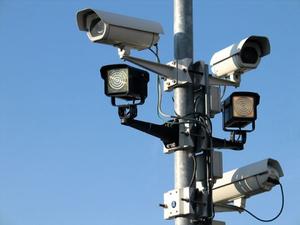SurveillanceAdvanced police surveillance technologies pose significant privacy concerns
Much of the attention on surveillance in the media focuses on the National Security Agency (NSA), but there is not a lot of scrutiny on local domestic surveillance. In 1997, about 20 percent of police departments in the United States used some type of technological surveillance. By 2007, that number had risen to more than 70 percent of departments. Experts in criminal law and information privacy warn that the widespread use of advanced surveillance technologies such as automatic license plate readers, surveillance cameras, red light cameras, and facial recognition software by state and local police departments, combined with a lack of oversight and regulation, have the potential to develop into a form of widespread community surveillance, which ought to pose significant privacy concerns to law-abiding citizens.

Police surveillance equipment raises alarms with privacy advocates // Source: congnghethongtinaz.com
The ever-increasing adoption of digital surveillance technologies by local police departments may dramatically improve the efficiency of criminal investigations, but it also creates the opportunity for abuse and misuse, a University of Illinois expert in criminal law and information privacy says.
A University of Illinois Urbana-Champaign release reports that Stephen Rushin, a professor of law at Illinois, warns that the widespread use of advanced surveillance technologies such as automatic license plate readers, surveillance cameras, red light cameras, and facial recognition software by state and local police departments, combined with a lack of oversight and regulation, have the potential to develop into a form of widespread community surveillance, which ought to pose significant privacy concerns to law-abiding citizens.
“What’s worrisome to me is that the technologies could be harnessed to monitor not just one person, but an entire community,” he said. “For example, if police departments use license plate readers in concert with an extensive network of surveillance cameras, that means that they really do have the ability to monitor everyone all of the time. Legally speaking, that’s troubling.”
In 1997, about 20 percent of police departments in the United States used some type of technological surveillance. By 2007, that number had risen to more than 70 percent of departments, according to a paper Rushin wrote that will be published next month in the Brooklyn Law Review.
“This radical shift in policing is the beginning of what I call the ‘digitally efficient investigative state,’ where technological replacements for traditional investigations are used to dramatically improve the efficiency of surveillance,” Rushin said.
While much of the attention on surveillance in the media focuses on the National Security Agency (NSA), there is not a lot of scrutiny on local domestic surveillance, Rushin said.
“I think that’s because it’s mostly local law enforcement that’s undertaking this type of surveillance, and we don’t tend to think of our local police force as being particularly scary, intimidating or worrisome,” he said.
While technologies that give the state an “extrasensory ability” may violate an individual’s reasonable expectation of privacy, technologies that merely improve the efficiency of otherwise permissible investigation techniques are presumptively permissible, Rushin said.
